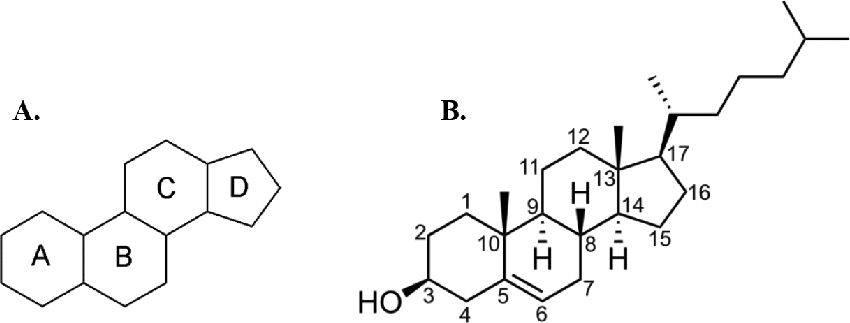Perhydrocyclopentanophenanthrene

Sterane, also known as perhydrocyclopentanophenanthrene or hexadecahydrocyclopenta[a]phenanthrene, refers to a quadricyclic alkane composed of three 6-atom cycles, denoted as A, B, and C, and one 5-atom cycle denoted as D. This structure contains 6 asymmetric carbons, with 2 atoms situated at each junction of two cycles (5 and 10, 8 and 9, 13 and 14). The term "sterane" invariably denotes any of the existing stereoisomers.
Gonanes are specifically referred to as the forms of sterane where the cycles B and C, and the cycles C and D, are in a trans configuration.
Sterane derivatives are commonly known as steranes and include compounds such as steroids and sterols. They are generated through diagenetic and catagenetic degradation and the saturation of sterane.
Steranes are occasionally utilized as biomarkers for the presence of eukaryotic cells.
Perhydrocyclopentanophenanthrene is a tetracyclic hydrocarbon that is the basic structure of all steroids. It is a complex molecule made up of four fused rings.
Steroids are a diverse group of organic compounds that play a vital role in human physiology. They are involved in a wide range of functions, including hormone production, cell signaling, and metabolism.
Perhydrocyclopentanophenanthrene is a stable molecule that allows steroids to adopt a variety of shapes. This makes steroids versatile molecules that can be tailored to perform a variety of functions.
Here are some examples of steroids:
- Cholesterol: Cholesterol is a steroid that is essential for cell membrane structure and hormone production.
- Testosterone: Testosterone is a steroid hormone that is important for male development and function.
- Estrogen: Estrogen is a steroid hormone that is important for female development and function.
- Cortisol: Cortisol is a steroid hormone that is involved in stress response and metabolism.
Perhydrocyclopentanophenanthrene is an important molecule that is essential for the structure and function of steroids. It is a complex molecule that is still not fully understood, but scientists are learning more about its role in biology all the time.
Steroids are a diverse group of organic compounds that play a vital role in human physiology. They are involved in a wide range of functions, including hormone production, cell signaling, and metabolism.
Perhydrocyclopentanophenanthrene is a stable molecule that allows steroids to adopt a variety of shapes. This makes steroids versatile molecules that can be tailored to perform a variety of functions.
Here are some examples of steroids:
- Cholesterol: Cholesterol is a steroid that is essential for cell membrane structure and hormone production.
- Testosterone: Testosterone is a steroid hormone that is important for male development and function.
- Estrogen: Estrogen is a steroid hormone that is important for female development and function.
- Cortisol: Cortisol is a steroid hormone that is involved in stress response and metabolism.
- Vitamin D: Vitamin D is a steroid hormone that is important for bone health and immune function.
Steroids are also used in a variety of medical applications, including:
- Treating inflammation: Steroids can be used to treat inflammation caused by conditions such as asthma, arthritis, and allergies.
- Treating cancer: Steroids can be used to treat certain types of cancer, such as leukemia and lymphoma.
- Preventing organ rejection: Steroids are used to prevent organ rejection after organ transplantation.
- Enhancing athletic performance: Some athletes abuse steroids to enhance their performance. However, this practice is dangerous and can have serious health consequences.
Perhydrocyclopentanophenanthrene is an important molecule that is essential for the structure and function of steroids. It is a complex molecule that is still not fully understood, but scientists are learning more about its role in biology all the time.
